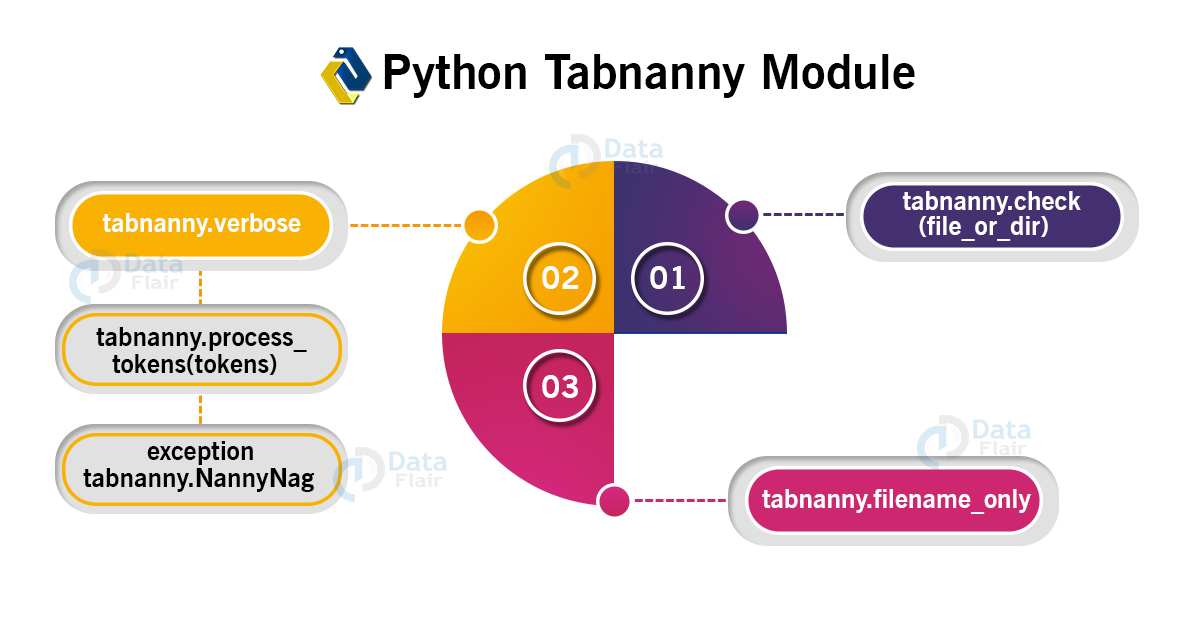Python Tools – 4 Major Utilities of Python
Python course with 57 real-time projects - Learn Python
In this Python Tools tutorial, we will focus on – Python Dis modules, Python PDB module, Python Profile module, and Python Tabnanny module with examples.
So, let’s start with Python Tools.
Which Python Tools are Commonly Used?
Here, we will discuss 4 types of Python Utilities.
1. Python Dis Module
To convert bytecode into a more human-readable format, Python has the ‘dis’ module.
You can say that it compiles a script, disassembles the bytecode, and prints the output to the STDOUT.
You can use it as a module or through the command line.
As an argument, we can pass a function, a method, a class, or a code object to the dis() function.
For Example
>>> def add():
a=3
b=4
c=a+b
print(f"{a}+{b}={c}")
>>> add()
3+4=7Now, we import the Python dis module and call the dis() function on it.
>>> dis.dis(add)
2 0 LOAD_CONST 1 (3)
2 STORE_FAST 0 (a)
3 4 LOAD_CONST 2 (4)
6 STORE_FAST 1 (b)
4 8 LOAD_FAST 0 (a)
10 LOAD_FAST 1 (b)
12 BINARY_ADD
14 STORE_FAST 2 (c)
5 16 LOAD_GLOBAL 0 (print)
18 LOAD_FAST 0 (a)
20 FORMAT_VALUE 0
22 LOAD_CONST 3 (‘+’)
24 LOAD_FAST 1 (b)
26 FORMAT_VALUE 0
28 LOAD_CONST 4 (‘=’)
30 LOAD_FAST 2 (c)
32 FORMAT_VALUE 0
34 BUILD_STRING 5
36 CALL_FUNCTION 1
38 POP_TOP
40 LOAD_CONST 0 (None)
42 RETURN_VALUE
2. Python Tabnanny Module
Python tabnanny checks code for ambiguous indentation.
It tells us about any weird combinations of tabs and spaces in the code. In Python, whitespace shouldn’t be ambiguous.
Like dis, we can run tabnanny from the command line or using the function check().
>>> import os
>>> import tabnanny
>>> os.chdir('C:\\Users\\lifei\\Desktop')
>>> tabnanny.check('nannydemo.py')
>>>Python Tabnanny module has the following methods:
a. tabnanny.check(file_or_dir)
This checks the file or directory we pass to it for examining whitespace-related issues. Then, it prints the diagnostic messages to the standard output.
b. tabnanny.verbose
This is a flag that depicts whether Python will print verbose messages.
c. tabnanny.filename_only
This is a flag that depicts whether Python should print only the filenames for those files that contain issues involving whitespace. It also has the following function:
tabnanny.process_tokens(tokens)
The tokenize module generates some tokens. check() uses process_tokens() to process these tokens.
Finally, this module may raise the following exception:
exception tabnanny.NannyNag
When process_tokens() detects an ambiguous indent, it raises this exception. check() captures and handles this.
3. Python Profile Module
We may sometimes like to know which parts of our code take the longest. So in a way, through profiling, we try to find bottlenecks in our code.
Other profilers in Python are cProfile and hotshot.
Let’s try this module with the cProfile module.
>>> import hashlib
>>> import cProfile
>>> cProfile.run("hashlib.md5('abcdefghijkl').digest()")4 function calls in 0.000 seconds
Ordered by: standard name
ncalls tottime percall cumtime percall filename:lineno(function)
1 0.000 0.000 0.000 0.000 <string>:1(<module>)
1 0.000 0.000 0.000 0.000 {built-in method _hashlib.openssl_md5}
1 0.000 0.000 0.000 0.000 {built-in method builtins.exec}
1 0.000 0.000 0.000 0.000 {method ‘disable’ of ‘_lsprof.Profiler’ objects}
We profile the creation of an MD5 hash here. The first output we get tells us that four function calls were made. These are ordered by standard name.
Here’s what all the other columns mean:
- ncalls- The number of calls made.
- tottime- Total time spent in a function.
- percall- The quotient of tottime divided by ncalls.
- cumtime- Cumulative time spent in this function and all subfunctions.
- percall- The quotient of cumtime divided by primitive calls.
- filename: lineno(function)- Data of each function.
4. Python PDB Module
Pdb is the standard Python debugger. It helps us debug our code line by line.
>>> import pdb
>>> n=4
>>> def raised(a):
return a**a
pdb.set_trace()
eight=raised(8)
>>> print(eight)
>>> two=raised(2)
>>> print(two)In the command prompt:
C:\Users\lifei\Desktop>python nannydemo.py
> c:\users\lifei\desktop\pdbdemo.py(6)<module>()
-> seven=raised(7)
(Pdb)
Now, we can use the commands of the pdb module to debug our code.
Important Interview Questions on Python Tools
- What are the various Python Tools and why they are used?
- Explain Python PDB Module.
- What are Profilers in Python and name some Python Profilers.
- Name some methods in Tabnanny Module.
- What is the use of Dis Module in Python?
Conclusion
These are few basic tools and utilities of Python: Dis modules, PDB module, the Profile module, and Tabnanny module with an example.
We work very hard to provide you quality material
Could you take 15 seconds and share your happy experience on Google




In this blog, the spelling of tabnanny is written as tbnanny in diagrams. Is there any specific reason for that or just a typo error.
It was just a typo mistake which has been rectified. Thanks for highlighting the same.
Hello there, Data Flair.
My opinion on python tools should be cover at the end of intermediate level because at the beginning it will cause problems for freshman learning python but is good context to follow for being a good python engineering
Yes for a complete beginner it might be hard to grab the concepts of the tools. But, a developer with basic knowledge can understand these concepts as this article covers the basic and important Python modules. Hope I could answer your question and that you enjoyed reading this article.
Yes for a complete beginner it might be hard to grab the concepts of the tools. But, a developer with basic knowledge can understand these concepts as this article covers the basic and important Python modules. Hope I could answer your question and that you enjoyed reading this article.